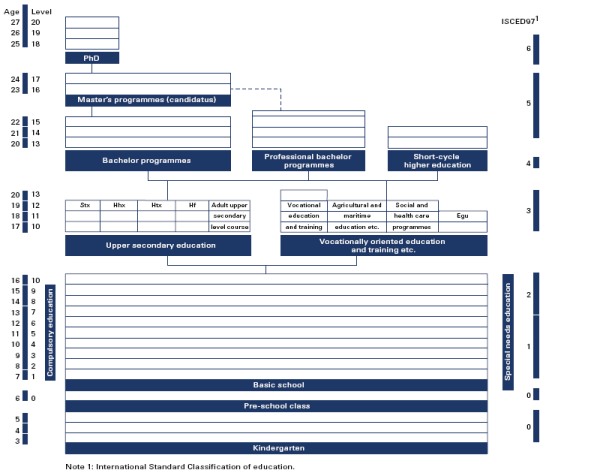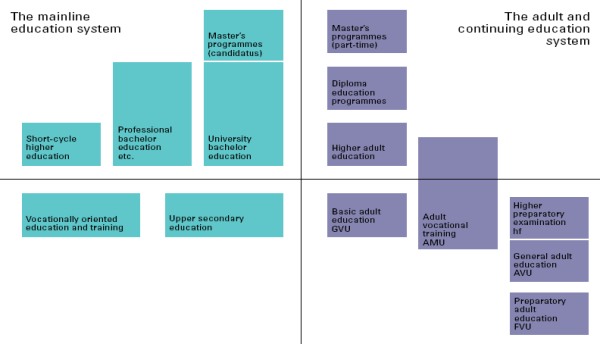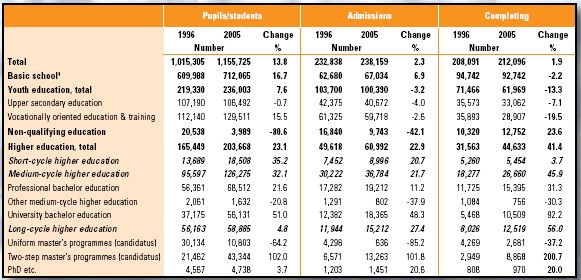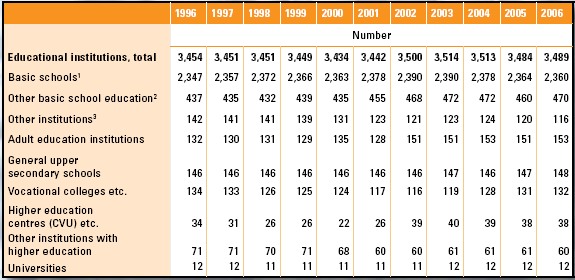
|

2 The education systemThe Danish education system may be divided into groups according to qualification level and field. Some education programmes give qualifications to further studies. This is frequently called study qualification. Other programmes give labour market qualifications Ė called vocational qualifications. There are education programmes that provide both forms of qualification. Moreover, there are educations that do not provide any formal qualifications. The education system is divided into the mainline education system and an adult and continuing education system. Figure 2.1 and 2.2 show the structures of and the connections between the mainline education system and the adult and continuing education system. During recent years, the further education system for adults has undergone a structural adaptation so that its education levels are now directly comparable with the mainline education system. In the following section, the education system is reviewed together with the framework, the contents, and the aims that apply to its various areas.
Figure 2.1. The mainline
Figure 2.2. The parallel education system 2.1 The mainline Danish education system
The basic school (primary and
lower secondary school) Almost all children begin their schooling in a one-year pre-school class that in most schools is an integral part of the school start progression. The pre-school class is optional for the pupils, but must be offered by the municipalities. There are nine years of basic school. The basic school gives admission to youth education; however, the pupils may choose to continue in a 10th form. A little less than half of the pupils in the 9th form of the basic school elect to continue in the 10th form; however, this proportion has been diminishing in the recent years. The basic school comprises various types of schools. The municipal basic school including special schools by far covers the teaching of the majority of the pupils. The municipal basic school is a free offer to parents. The private basic schools and the continuation schools are alternatives to the municipal basic schools. Continuation schools are private boarding schools that typically offer teaching at the 8th through 10th form level. The private basic schools and the continuation schools are self-governing institutions financed by state subsidies and pupil contributions. In the year 2005, there were 712,100 pupils in basic school. Of these, 596,300 pupils attended a municipal basic school. The private basic schools had 90,800 pupils, while 24,900 pupils attended a continuation school. According to the Basic School Act, the purpose of the municipal basic schools is to bring to the pupils, in cooperation with the parents, knowledge and skills that: ďPrepare them for further education and give them the desire to learn more, familiarize themselves with Danish culture and history, provide them with an understanding of other countries and cultures, contribute to their appreciation of the interaction between man and nature, and promote an all-round development of the individual pupilĒ. Pupils in the municipal basic schools are normally taught in classes that remain together throughout the entire course of the basic school. The teaching is differentiated within the framework of the class so that the teaching is based on the requirements and qualifications of the individual pupil. The private basic schools offer teaching to children in the age bracket of compulsory education, and it must measure up to what normally is required in the municipal basic schools; however, the framework for planning the teaching is more open. There are a few other forms of school that offer teaching at the basic school level. There are for example special schools for children, schools in connection with daytime therapy, therapeutic institutions, and parts of the municipal youth school offers. Some pupils have so great physical and psychical difficulties that their education cannot be dealt with in the regular teaching. Therefore, they receive special needs education. Until the 1st of January 2007, there were two forms of special needs education: the general special needs education, which was the responsibility of the municipalities, and the extensive special needs education, which was the responsibility of the counties. In the year 2005, approximately 13,800 pupils attended general special needs education, and 11,500 pupils attended extensive special needs education. Today, all special needs education is the responsibility of the municipalities, and it is no longer split up in general and extensive special needs education. In the international ISCED97 classification, the pre-school class corresponds to level 0, and the basic school corresponds to level 1 (1st through 6th form) and level 2 (7th through 10th form). Youth education Youth education includes the upper secondary education and the vocationally oriented education and training programmes. The youth education may prepare the students for further studies or for a profession or both. In either case, the emphasis is on developing the personal, professional, and theoretical qualifications of the students. Most youth education takes approximately three years; however, the duration may be anywhere from one year and a half and up to more than five years. Through a differentiated offer and planning of the education, the individual skills and wishes of the students may largely be taken into consideration. The purpose is to secure a high level of motivation so as many young people as possible complete the education. The latest calculations based on the educational behaviour in 2005 show that 81 % of a youth cohort are expected to complete a youth education. It is the goal of the government that at least 85 % of a youth cohort complete a youth education in the year 2010 and at least 95 % in 2015. On the 1st August 2007, new legislation took effect to give young people with special needs who cannot complete an ordinary youth education a legal right to a three-year course of education.
Upper secondary education All pupils who have received the relevant instruction and have passed the prescribed tests in the basic school may continue to an upper secondary youth education, unless the dismissing school appraises that the pupil has made the choice on an inadequate or unrealistic basis. In this case, the pupil is entered for an entrance examination. Stx, hhx, and htx are three-year education programmes with a common half-year foundation course followed by two and half years in a programme chosen by the student. Within certain limits, the schools themselves plan which programme should be offered to the students. Hf is offered as a two-year youth education programme as well as a programme for adults composed of single subjects. Hf comprises mandatory subjects and optional subjects; this gives the opportunity to put together an individual education programme. Hf is intended as a youth education offer to somewhat older students. It is not possible to go from the basic school 9th form directly to hf. Hf is frequently offered together with stx in upper secondary schools, while hhx and htx are offered in vocational schools. For many years, vocational schools have been selfgoverning institutions financed by the government. Following the municipal reform, which took effect the 1st January 2007, the upper secondary schools have been transferred from the counties into self-governing institutions financed by the government. There are a small number of private upper secondary schools and adult upper secondary level courses where the students pay a part of the tuition. The final examination completing an upper secondary education qualifies to enter higher education. However, the higher education programmes may pose requirements concerning subjects, level and the grade obtained.
Vocationally oriented education
and training All vocationally oriented education and training programmes give formal vocational qualifications. The education is also intended to prepare the students for a higher education. Normally, the only requirement for admission to a vocationally oriented education and training programme is that the applicant has completed the compulsory education in the basic school. Some of the vocational schools have a proportion of adult students, especially in case of social and health care training programmes. The vocational education and training programmes (EUD) account for the greater part of vocational youth education. The total duration of a vocational education and training programme is between one and a half years and five and a half years. However, the norm is three to four years. Vocational education and training is a multitude of diverse programmes. As of 1st January 2007, it consists of about 120 programmes in the commercial and technical fields. There are seven entry points into vocational education and training, each consisting of a base course of study and a main course of study as well as a practice period. For the individual student, the base course of study may be substituted fully or partially by basic, practical training in an enterprise based on a training contract. In order to plan the course of education individually, each student together with the school and the business enterprise where the practice takes place shall develop a personal education plan. A vocational education and training programme starts either in a school Ė that is normally the case Ė or in practice. In EUD, there is free admission to the base course of study, and entry is continuous. In total, approximately 30-50 % of the time is spent in school and 50-70 % in the practice enterprise or in school practice organized by the vocational college if it is not possible to get a sufficient number of practice placements in enterprises. Vocational education and training is undergoing change. With a reform as of 1st August 2007, a common legislative framework for vocational education and training, basic social and health care training programmes, and agricultural education has been created. The purpose of this education has been adjusted; increased emphasis is placed on internationalization and education guarantee, and the effort against dropouts is intensified. The seven common entry points are replaced by 12 common entry points, and the base course of study is remodelled so that both students with weak study qualifications and students with strong study qualifications are benefited. There will be better opportunities for dividing the education into steps and levels and for individual courses of study. The effort to gain more practice placements and the quality of school practice will be strengthened. The present education programmes will continue in a transitional period. The new entry structure has been implemented, and the new education programmes have been developed. Students under 25 years of age who have already completed the first step of an education may return after a minimum of half a year of relevant vocational experience to complete the education in a course of study called EUD+. Adults over 25 years of age with vocational experience in the field in question have the opportunity to complete the course of study in a shorter time based on an appraisal of their prior learning and a subsequent crediting of competencies. If the requirement of two years of relevant vocational experience is met, this may take place as a basic adult education (GVU). A relevant vocationally oriented education and training programme gives admission to a number of shortcycle higher education programmes and certain professional bachelor programmes. Social and health care training programmes (SOSU), like the alternating EUD programmes, consist of a combination of practice and school studies. The SOSU programmes comprise the social and health care helper education (one year and two months) as well as an extension to social and health care assistant (one year and eight months). The admission requirement to the education for social and health care helper is the completion of the basic course of study or other relevant trade experience. The social and health care training programmes also include the educational childworker and care assistant training (PGU). The PGU programme qualifies the students for pedagogical and care-related work with children, young people and adults as pedagogy assistants, registered child minders and special needs care assistants etc. The duration of PGU is seven and one half months. The admission requirement is a basic SOSU course of study or other vocational or teaching experience. After the basic course of study, the education is undertaken based on an employment contract between the student and an engaging municipal authority. Furthermore, within the field of vocationally oriented education and training, there is a series of vocational agricultural and maritime education programmes. The duration of the skilled farmer education is three and a half years and alternates between practice and school. Maritime education comprises for example able seaman, fisherman, coastal shipmaster, etc. The basic vocational education and training (egu) is an individually planned offer of education to young people under 30 years of age who do not qualify directly for another youth education leading to formal qualifications. The course of study is primarily based on practice and alternates between time in school and time in practice. The duration of this education is normally two years; however, it may be extended by an additional year of practice. In total, the time in school is from 20 to 40 weeks, and normally consists of courses from the established education programmes, for example the vocational education and training programmes, the adult vocational training programmes, the social and health care training programmes, or the agricultural programmes. The periods of practice take place in one or more enterprises or as workshop practice in a technical school, a production school or similar. A completed egu education provides vocational qualifications and the opportunity to continue in a general vocational education and training programme with credit transfer. The youth education programmes comprise level 3 of the ISCED97 classification. Production schools The purpose of this education is to strengthen the studentsí personal development and to improve their opportunities in the education system and in the general labour market. The offer is planned with the specific aim that young people acquire qualifications that may result in the completion of a vocationally qualifying youth education. The education programme is based on activities in diverse workshops and comprises practical work and performance of tasks in combination with theoretical training in actual production and marketing. Furthermore, the schools offer teaching in general subjects so the students are prepared to start a general youth education. Up to one third of the course of study in a production school may be spent on studies in other educational institutions. For example, these may include studies of general subjects in an adult education centre (VUC) or parts of a basic course of study in a vocational college. Furthermore, the students may participate in practice for four weeks each semester. Higher education The latest calculations based on the educational behaviour in 2005 show that 44 % of a youth cohort will complete a higher education. It is the goal of the government that at least 45 % of a youth cohort complete a higher education in the year 2010 and at least 50 % in 2015. As a rule, higher education is free in Denmark. However, the students normally pay for books and other teaching materials. For most higher education, the schools themselves decide how many student seats are established. For some education programmes, however, the number of student seats is decided centrally; this is the case for the medical, veterinary, and dentistry schools. To be admitted to a higher education, the applicant must meet the entry requirements demanded by the school in question. For example, in order to be admitted to a university bachelor education programme, the applicant must meet the entry requirement of a general upper secondary graduation diploma including certain upper secondary subjects at a specified level. Furthermore, some bachelor programmes require that the upper secondary exam be passed with a certain minimum mark in average or in individual subjects. A vocational academy education is a short-cycle higher education that as a rule takes two years. These education programmes are often directed towards a specific trade or job function, and they combine theory and practice. The requirement for admission to a vocational academy education is an upper secondary education or a vocationally oriented education, typically complemented by requirements of certain academic levels in mathematics and English. Today, there are ten technical and eight commercial vocational academy education programmes and three other short-cycle higher education programmes (pharmacy assistant, transport logistician, and offshore technical manager). Short-cycle higher education may give admission to relevant diploma education programmes. A professional bachelor education is a profession-oriented, qualifying medium-cycle higher education. The programmes for professional bachelor education normally take three to four years including a minimum of half a year of practice. A professional bachelor education combines theory and practice and is most often directed towards a certain trade or job field. The entry requirements for the professional bachelor programmes are in most cases a general upper secondary education (whole or in parts); however, certain vocational education and training programmes (EUD) complemented by general upper secondary courses also provide admission. Today, there are approximately 30 professional bachelor education programmes within health care, biotechnology, laboratory technology, media and communication, pedagogy, technology, social sciences, and economics. A professional bachelor education provides admission to relevant masterís programmes (candidatus) and masterís programmes (part-time). The greater part of the professional bachelor education takes place at centres for higher education (CVU). Starting 1st January 2008, the present CVUs and seven individual institutions among the medium-cycle higher education schools enter into eight university colleges for higher education. Among other medium-cycle education programmes, there are for example: fine arts education, maritime/navigation education, sign language interpreter, armed forces education, etc. The duration of these programmes varies. At the same level as the professional bachelor education programme, there is the three-year bachelor education programme in the universities. The bachelor education is a complete education giving vocational qualifications as well as access to a twoyear masterís programmes (candidatus). The current structure of the university education was established in 1993 when it was decided to divide the long-cycle university education programmes leading to a masterís degree (candidatus) into two shorter courses of study: a bachelor course of study and a masterís (candidatus) course of study. Formerly, there had been only the complete course of study leading to the masterís degree (candidatus) as the first academic degree. Today, all long-cycle higher education programmes in university consist of a three-year bachelor programme followed by a two-year masterís programme (candidatus). Henceforth, the education may be extended further by a three-year PhD programme (the so-called 3+2+3 model). As a rule, the entry requirement for the bachelor programmes in university is a general upper secondary education plus possibly meeting specific requirements for course subjects and level. Admission to the masterís programmes (candidatus) presupposes a relevant bachelor degree or another relevant Danish or foreign education at the same level. As a superstructure to the masterís programmes (candidatus), there is a research education leading to a PhD degree. This education is normalized to three years of full-time studies. The programme includes the completion of an independent research project under supervision and the preparation of a written thesis based on the PhD project, the completion of research courses corresponding to approximately 30 ECTS points, participation in active research environments through residences in other, primarily foreign, research institutions, as well as acquiring experience in teaching or another form of communication skills. The entry requirement to a PhD programme is normally a masterís degree (candidatus), although it is possible to be admitted before the masterís programme (candidatus) has been completed. It must be ensured, however, that the combined course of study has the same magnitude and is at the same level as if the PhD programme were started after the completion of the masterís degree (candidatus). The higher education programmes comprise level 5 of the ISCED97 classification. The PhD education is considered level 6 in the ISCED97 classification.
Pupils/students and educational
institutions within regular education Table 2.2 shows the development in number of educational institutions over a period of ten years. The table shows the juridical units Ė that means main schools and independent institutions. Main schools are administrative units. Each main school has one or more subdivisions. Table 2.1. Number of pupils/students in the Danish education system, and number of admissions and pupils/ students completing the education programmes, 1996 and 2005
Table 2.2. Number of educational institutions
2.2 The adult and continuing education systemDenmark has a long tradition of popular enlightenment and adult education. Adult and continuing education (VEU) may be divided in three categories: formally qualifying education, education not formally qualifying, and private courses. Formally qualifying adult and continuing education may be divided into general and vocational education programmes. Among other things, the adult education programmes comprise: Preparatory adult education (FVU) with the purpose to give adults the opportunity to complement their basic skills in reading and mathematics. Both subjects are divided into steps, and it is possible to submit to a test after each step. General adult education (AVU) is an offer to adults over 18 years of age to improve their knowledge in a series of general subjects, for example Danish, mathematics and social studies. AVU may be concluded with tests corresponding to the 9th and 10th form in the basic school. Higher preparatory single subject course (single subject hf ) with the purpose that adult participants achieve a general education, knowledge, and qualifications forming the basis for further education or increasing their opportunities in the labour market. Single subject hf may be concluded with tests corresponding to the general upper secondary levels. Among other things, the vocational adult and continuing education programmes comprise: Adult vocational training (AMU) consisting of approximately 3,000 different adult vocational training programmes and a selection of single subjects from vocational education and training programmes leading to distinct qualifications to perform unskilled and skilled tasks. Adult vocational education and training is special adult courses of study within the ordinary vocational education and training. Basic adult education (GVU), which is the framework in which previous education and relevant trade experience, complemented with elements of vocational education and training and adult vocational training courses (AMU) among other things, are combined into a formal vocational education and training programme. The continuing education system for adults (VFV), which comprises higher adult education (VVU) as well as diploma and masterís programmes (part-time), provides qualifications at the same level as bachelor, respectively masterís programmes (candidatus). Open education programmes aim to further a wide spectrum of vocationaloriented education offers to the adult population and comprise among other things part-time education, single subjects, and subject-specific courses. Among education programmes not giving formal qualifications, there are studies in evening classes, folk high schools and day folk high schools. The scope of the studies within various types of adult education varies from a few hours to complete full-time courses of study of several yearsí duration. The courses are normally taken on a part-time basis. A part of the courses in the open education programme takes place as distance learning. The adult education programmes may be publicly and/or privately financed. In parts of the public area, a principle of student payment in part has been introduced. In certain education programmes, the state provides a subsidy for living expenses. Adult and continuing education completed with a consolidated qualification, for example single subject hf and diploma and masterís programmes (part-time) are placed at level 3-5 in ISCED97 classification and are counted in the international statistics (Education at a Glance). Standalone single subjects and AMU courses are not counted.
Prior learning The appraisal of prior learning will be implemented during the course of the years 2007 and 2008. After that time, all individuals will have the opportunity to have their prior learning appraised and acknowledged. The appraisal will take place in an educational institution and in relation to the education program to which the individual wishes to be admitted, to have shortened, or to have certified. This scheme will come into force for all adult and continuing education up to and including the diploma level. For the individual, an appraisal of prior learning may be used to meet entry requirements to an education programme, to shortening or individually planning a specific education or to obtain certification of parts of an education programme.
|
||
|
To the top of the page |



